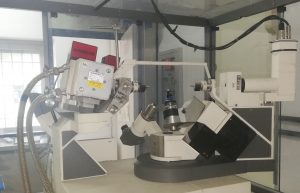Through single-crystal X-ray diffraction study, the atomic structure of crystalline solids can be understood, because it is possible to obtain a 3D model of the arrangement of atoms, molecules or ions forming a crystal. In the laboratory can be performed single-crystal X-ray diffraction experiments at ambient conditions on inorganic crystals, as well as on small-molecule organic or organometallic crystals (with, in general, fewer than 100 atoms in the asymmetric unit). Samples must be available as macrocrysts greater than 0.2 x 0.2 x 0.2 mm. X-ray diffraction analysis can be useful for: Mineralogy: phase identification and crystal-chemical studies; understanding of relations among crystal structure, environments of formation, physical features and potential technological applications for rock forming minerals.
Inorganic, organic and metallorganic chemistry: characterization of molecular structure (stereochemistry) and of its relation to chemical activity; characterization of intermolecular interactions (supramolecular chemistry) and of their changes with the chemical environments. Pharmaceutics: characterization of the molecular structure of an active principle (including the absolute configuration) and clarification of its relation to biological activity of drugs. Material science: enlightening of relations between atomic-scale arrangement and properties exhibited by technologic material.
Equipment

- Single-crystal automatic diffractometer (ENRAF-NONIUS CAD4) equipped with punctual detector and graphite-monochromated Mo-Kα X-radiation
.
